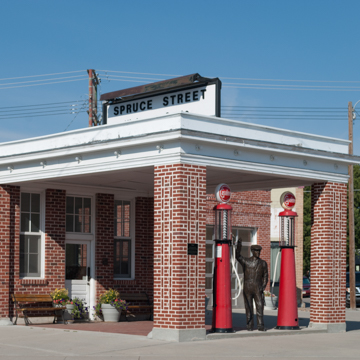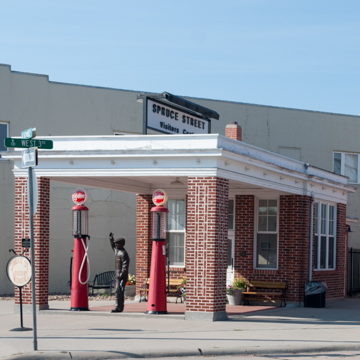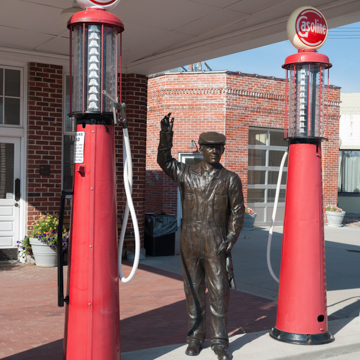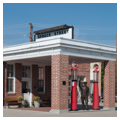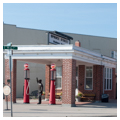You are here
Spruce Street Visitor Center
Currently housing the Spruce Street Visitor Center, the property was originally the Standard Oil Red Crown Service Station. The station typifies the early evolution of retail marketing by the Standard Oil Company at a time when the automobile was emerging as a popular mode of transportation, a trend that was accelerated by the improvement of roads and development of the highway system. Ogallala made sense as the site of a Standard Oil station since it was the county seat and the center of a large rural trade area, and, perhaps most importantly, was located on the Lincoln Highway, one of the country’s major historic east-west routes.
Located on the main business thoroughfare, the station sits diagonally on a corner lot facing the intersection. It was built in 1922 in accordance with the Standard Oil Company’s standardized plan: a small, one-story brick structure capped by a brick stringcourse contained the office, and a flat canopy, supported by brick piers, extends outward to shelter two gasoline pumps. The plan first appeared in 1920 and was developed by father-and-son architects, John and Alan McDonald of Omaha. Both sections of the structure have a wood roof with a cornice and parapet. The office interior is finished with painted masonry walls and a pressed metal ceiling.
Following retail trends in subsequent decades, the filling station became a service station, first with the construction of an outdoor pit for lubrication in the 1920s, and then in 1937 with the construction of a detached service bay to expand the station’s product lines. This service bay originally housed a hydraulic hoist, tire storage, and a small shop area that accommodated automobile repairs, tire changing, lubrication, and car washing.
The station operated under the “Standard” name until 1976 when it came under local, independent ownership until 1984. Gasoline retailing changed dramatically in those years as most stations offered multiple fueling points, service bays and, increasingly, a mix of automotive and non-automotive goods for sale. The small station in Ogallala was unable to survive in this increasingly competitive environment and closed in 1984. Rehabilitated in 2002–2003, the station is now owned by the City of Ogallala. Both the original office and service bay provide office and meeting space for the visitor center.
References
Puschendorf, Robert L., “Standard Oil Red Crown Service Station,” Keith County, Nebraska. National Register of Historic Places Registration Form, 2004. National Park Service, U.S. Department of the Interior, Washington, DC.
Writing Credits
If SAH Archipedia has been useful to you, please consider supporting it.
SAH Archipedia tells the story of the United States through its buildings, landscapes, and cities. This freely available resource empowers the public with authoritative knowledge that deepens their understanding and appreciation of the built environment. But the Society of Architectural Historians, which created SAH Archipedia with University of Virginia Press, needs your support to maintain the high-caliber research, writing, photography, cartography, editing, design, and programming that make SAH Archipedia a trusted online resource available to all who value the history of place, heritage tourism, and learning.














